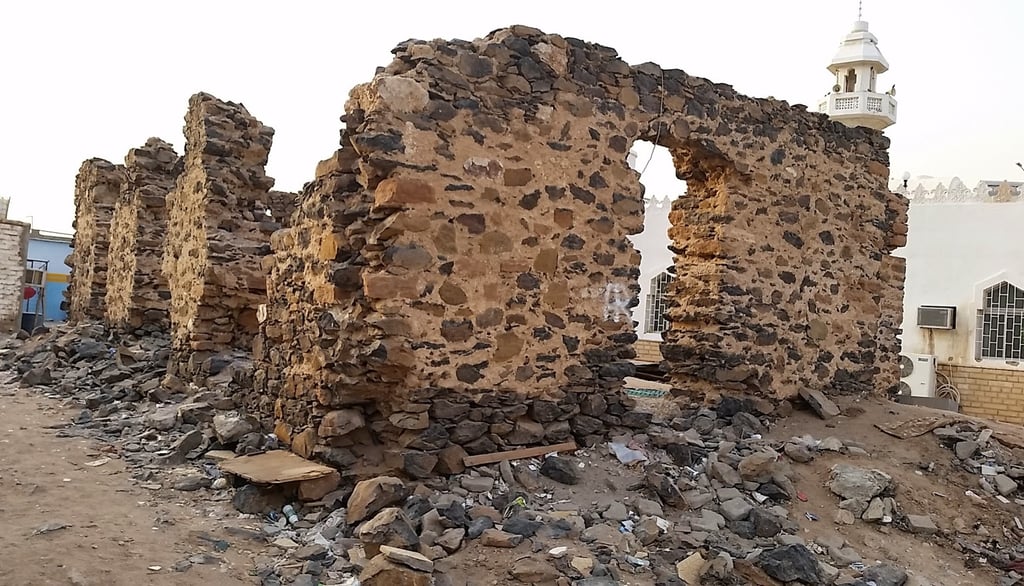Embark on a journey to Sulah Hudaibya and the Well in Makkah, KSA. Uncover the rich history, spiritual significance, and practical tips for an unforgettable visit. 🌍✨
Welcome to a captivating exploration of Sulah Hudaibya and the Well, nestled in the heart of Makkah, KSA. This sacred site holds profound historical significance, inviting tourists and pilgrims alike to delve into its rich tapestry of stories.
MAKKAH
ME
12/14/20235 min read


Discovering Tranquility: Unveiling the Mysteries of Sulah Hudaibya and the Well in Makkah, KSA 🕋
Introduction:
Welcome to an intriguing exploration of Sulah Hudaibya and the Well, located in the heart of Makkah, KSA. This revered site boasts significant historical importance, inviting tourists and pilgrims to immerse themselves in its deep historical narratives.
The Hudaibiyah incident marks a significant phase in Islamic history when Muslims unexpectedly turned potential defeat into a strategic advantage.
In the sixth year of Hijrah, the Prophet (peace be upon him) and his followers, eager to visit the holy Kaaba and perform tawaf (circumambulation), were met with resistance from the Quraysh tribe. Despite earlier confrontations in the Battle of Badr, Battle of Uhud, and the Battle of the Trench, the Muslims, though victorious in two of these battles, were not yet in a position to challenge the Quraysh force.
During the Hudaibiyah encounter, the Muslims' resolve was tested, and their courage and faith were affirmed. In 628 CE, the Prophet (peace be upon him) dreamt of entering Makkah and performing tawaf, a sign he took as a divine indication to visit Makkah for Umrah.
Accompanied by over 1,400 Muslims and 70 camels for sacrifice, they faced obstruction from the Quraysh leaders, who dispatched Khalid Bin Walid with 200 fighters to prevent their entry. To avoid conflict, the Prophet (peace be upon him) altered the route and stopped at Hudaibiyah on the city’s outskirts.
The Quraysh then sent Urwah bin Masud to negotiate. Impressed by the Prophet’s rapport with his followers, Urwah recommended allowing them into the city, but the Quraysh leaders remained resolute.
The Prophet (peace be upon him) sent Uthman bin Affan for further negotiations, but he was detained and rumors of his death spread. In response, the Prophet (peace be upon him) prepared for a possible conflict, rallying his followers to pledge their support. This show of unity persuaded the Quraysh to consider peace talks.
The resulting treaty, known as the Treaty of Hudaibiyah, included several terms: a 10-year truce, freedom for tribes to ally with either side, the return of Meccan emigrants to their homeland, and a provision for Muslims to perform Umrah the following year. Though initially viewed as disadvantageous, the treaty turned out to be a strategic victory for the Muslims.
The treaty recognized the Prophet (peace be upon him) as the leader of Madinah, allowed Muslims to freely practice and discuss Islam, and provided a crucial 10-year period to spread Islam and address rivals. The eventual return to Makkah for Umrah was guaranteed, and the Prophet (peace be upon him) avoided conflict in the holy city.
The agreement led to increased acceptance of Islam, with many embracing the faith. The following year, when the Prophet (peace be upon him) returned for Umrah, the number of pilgrims had grown to 2,000.
The Qur'an later described the treaty as "Fatah Al-Mubeen" (Manifest Victory) and affirmed the honor of those who pledged under the tree known as Bait Ridwan. Despite initial disappointment, the wisdom of Umm Salma helped resolve the situation when the Prophet (peace be upon him) acted upon her advice to encourage his followers.
The treaty's clauses, particularly those about returning individuals, were initially difficult but were ultimately seen as opportunities for the growth of Islam. The eventual abrogation of the treaty's terms due to the betrayal of the Quraysh led to the peaceful conquest of Makkah.
The events surrounding Hudaibiyah are commemorated by a mosque near Shumaisi, about 20 km from Makkah, where the Prophet (peace be upon him) prayed. Visiting this site offers a moment to reflect on the sacrifices made for Islam and honor those who pledged their lives for the faith.
Unveiling the History 📜:
Sulah Hudaibya, also known as the Treaty of Hudaibya, is a landmark event in Islamic history. Signed in 628 CE, this treaty represented a period of peace between the Muslims and the Quraysh tribe. The Well, an essential water source at that time, symbolizes perseverance and diplomatic efforts
The Spiritual Aura 🤲:
As you approach Sulah Hudaibya, feel the spiritual aura enveloping you. The site stands as a testament to the Prophet Muhammad's wisdom and diplomacy. Take a moment to reflect on the lessons of peace and compromise that echo through the ages.
Practical Tips for Tourists 🗺️:
1. Visiting Hours: Sulah Hudaibya is open to visitors during regular hours. Check ahead for any special events or closures.
2. Modest Attire: Respect the cultural norms by dressing modestly. This includes covering shoulders and knees.
3. Guided Tours: Opt for a guided tour to gain deeper insights into the historical context and significance.
4. Photography: Capture the beauty but be mindful of the sacredness of the site. Avoid photographing individuals without permission.
Exploring the Surroundings 🌳:
Take a relaxed walk around the Well, which is surrounded by verdant greenery. Appreciate the timeless architecture and immerse yourself in the peaceful ambiance of this sacred area. The blend of history and nature creates a truly enchanting experience.
Reviews from Visitors 🗣️:
Ahmed, USA: "Sulah Hudaibya is a must-visit for anyone seeking a profound spiritual experience. The peaceful ambiance and historical resonance left me in awe."
Maria, Spain: "I felt a deep connection to the past while standing by the Well. The guided tour was informative, and the surroundings are simply breathtaking."
Closing Thoughts 🌟:
Sulah Hudaibya and the Well in Makkah, KSA, beckon with open arms, offering a profound journey through time and spirituality. Whether you're a history enthusiast or a seeker of tranquility, this sacred site promises an experience like no other. Plan your visit, absorb the rich history, and let the serenity of Sulah Hudaibya leave an indelible mark on your soul.
Explore, reflect, and embrace the beauty of this hidden gem in Makkah. Your journey to Sulah Hudaibya awaits!
FAQs 🤔:
What is Sulah Hudaibya and why is it significant?
Sulah Hudaibya, also known as the Treaty of Hudaibya, was a peace treaty signed in 628 CE between Muslims and the Quraysh tribe. It marked a pivotal moment in Islamic history by establishing a period of peace and allowing Muslims to perform Umrah.
Can non-Muslims visit Sulah Hudaibya?
Yes, Sulah Hudaibya is open to visitors of all faiths, allowing everyone to experience its historical and spiritual significance.
What are the visiting hours for Sulah Hudaibya?
Sulah Hudaibya is accessible during standard hours. It is advisable to confirm visiting times and any potential closures in advance.
Are there any entry fees to visit Sulah Hudaibya?
There is no charge to enter Sulah Hudaibya. However, guided tours may have a nominal fee, so check with the tour provider for specific details.
What should I wear when visiting Sulah Hudaibya?
Visitors should dress modestly, covering shoulders and knees, in accordance with cultural norms.
Is it necessary to take a guided tour of Sulah Hudaibya?
While not mandatory, a guided tour is recommended for a deeper understanding of the site's historical context and significance.
Can I take photographs at Sulah Hudaibya?
Photography is allowed, but visitors should be respectful of the site's sacredness and avoid taking photos of individuals without permission.
Are children allowed at Sulah Hudaibya
Yes, families with children are welcom, but it is important for children to respect the site's sanctity.
What is the historical background of the Well at Sulah Hudaibya?
The Well at Sulah Hudaibya was a crucial water source at the time of the treaty and symbolizes the perseverance and diplomatic efforts involved in the peace process.
How did the Treaty of Hudaibya impact the spread of Islam?
The treaty, although initially perceived as unfavorable, turned out to be a strategic victory. It allowed Muslims to practice their faith more openly and facilitated the growth of Islam, leading to increased acceptance and the eventual peaceful conquest of Makkah.
Links
Socials
Subscribe to our newsletter


KSA Journeys is dedicated to showcasing the very best of Saudi Arabia’s destinations from its awe-inspiring natural landscapes to its rich cultural heritage. Our mission is to provide travelers with an easy, enjoyable, and immersive experience as they explore the Kingdom’s most iconic sites, hidden gems, and spiritual landmarks. Whether you're seeking adventure, relaxation, or cultural discovery, KSA Journeys is your trusted companion for unforgettable travel in Saudi Arabia.
Use full Links
Contact Us



